
| What is Flavor and Fortune? |
| How do I subscribe? |
| How do I get past issues? |
| How do I advertise? |
| How do I contact the editor? |
Read 13035691 times
Connect me to:
| Home |
| Articles |
| Book reviews |
| Letters to the Editor |
| Newmans News and Notes |
| Recipes |
| Restaurant reviews |
| Article Index (all years, slow) |
| List of Article Years |
| Article Index (2025) |
| Article Index (last 2 years) |
| Things others say |
| Related Links |
| Log In... |
| Authors |
| Categories & Topics |
Cruising for Chinese Restaurants in Europe
| by Jacqueline M. Newman |
Chinese Food in Europe
Spring Volume: 2006 Issue: 13(1) page(s): 27, 28, 33, and 38
Large cities can have fine Chinese restaurants. Smaller cities used to be less fortunate because they serve fewer folk who really know good Chinese food. As their owners may have less of an appreciative and knowledgeable audience, their foods may be less typically Chinese.
We set about testing this theory on a European River cruise that made port only in small European cities and towns. Before sailing we stayed a few days In the Belgian city of Brugge to relive an earlier love affair with that small city and to begin thinking about places without large Chinese populations. That visit was wonderful and is recorded in Flavor and Fortune’s Volume 12(4) on pages9, 19, 21, and 28. There we set out our plans for each port on the river cruise, ready for this reporting adventure.
These were to be short single-day excursions to Chinese restaurants, not full-scale restaurant reviews. We only wanted to evaluate their menus and what they serve, what the Chinese food looked like, and what Chinese restauranteurs experience was, vis-a-vis types of patrons, etc. In previous trips to Europe we drove place to place. Then, we had visited close to half the small cities on the upcoming cruise, and often for several days. Others on this trip, were first forays; and all were but single day opportunities.
Web materials and city tourist offices advise about Chinese eateries in each port place, as did well-traveled Chinese and non-Chinese folk we knew. Travel guides were also perused in places specializing in printed guide books. And, before lunch or dinner hour, depending upon sailing plans, we did query Chinese and other Asian tourists seen in each city or town visited.
Except for Boppard, we met at least one person who advised about place or places in their port place. These include Andernach, Antwerp, Baden-Baden, Basel, Bernkastel, Boppard, Strasbourg, Traben-Trabach, Trier, and Worms. Ghent would otherwise be among this list, but a small space in the previous issue needing filling, and that was published there. The locations investigated are alphabetical, not by country, nor directional nor in the actual order visited.
ANDERNACH,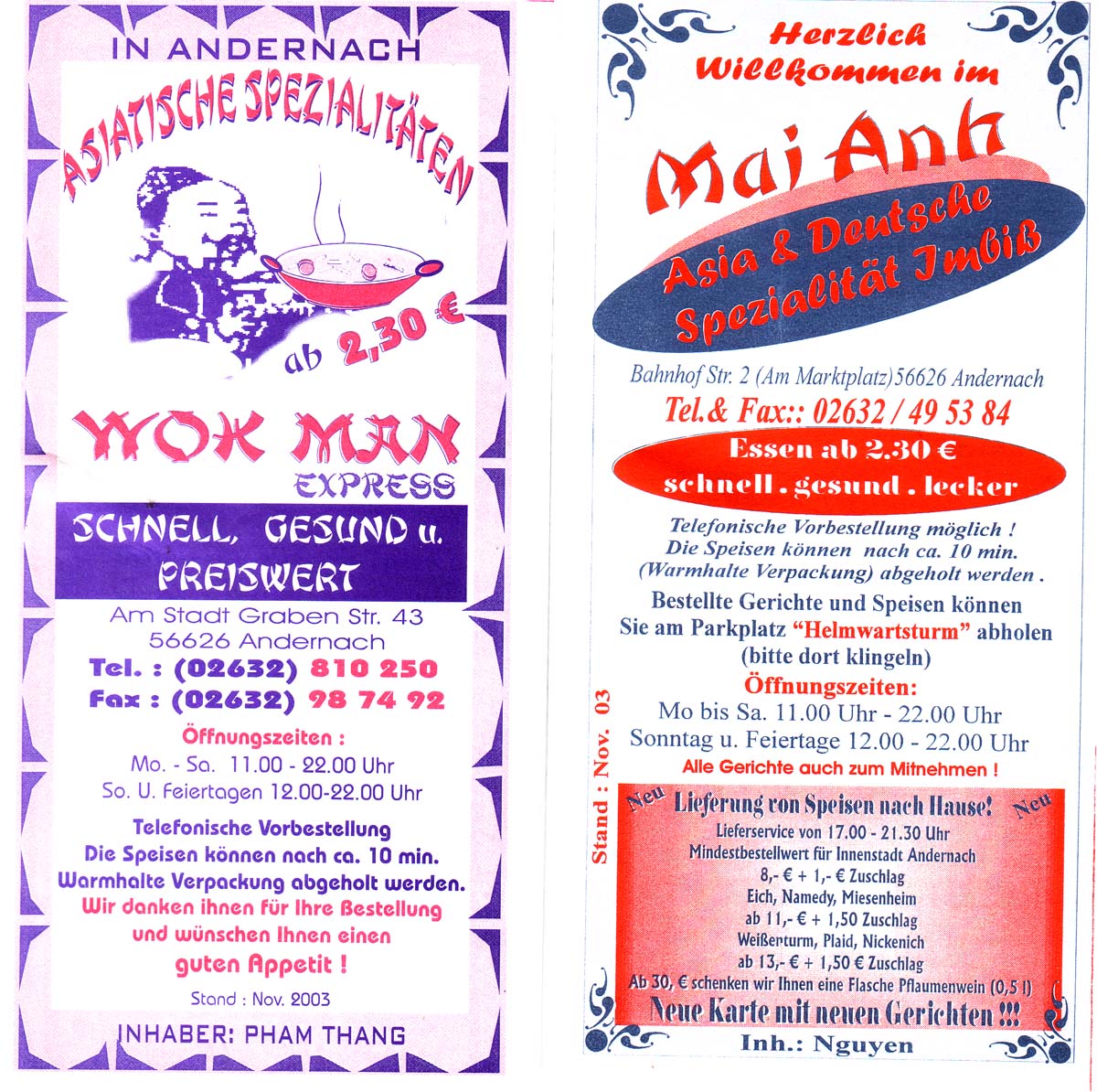 a city of thirty thousand in Germany, is on the Rhine River. Germany has eighty-two million folk that live in less area than Montana; and forty percent is forested. As small as it is, this city has two Chinese restaurants, both qualifying as eat-in-take-away rather than places for fine dining. Both pride themselves as fast, healthy, and fair-priced, and both serve foods of several Asian countries (see their take-away menu pictures). The Chinese foods served has considerable Germanic influence, and both are owned by young Vietnamese who advise that almost no Chinese live here.
a city of thirty thousand in Germany, is on the Rhine River. Germany has eighty-two million folk that live in less area than Montana; and forty percent is forested. As small as it is, this city has two Chinese restaurants, both qualifying as eat-in-take-away rather than places for fine dining. Both pride themselves as fast, healthy, and fair-priced, and both serve foods of several Asian countries (see their take-away menu pictures). The Chinese foods served has considerable Germanic influence, and both are owned by young Vietnamese who advise that almost no Chinese live here.
ANTWERP,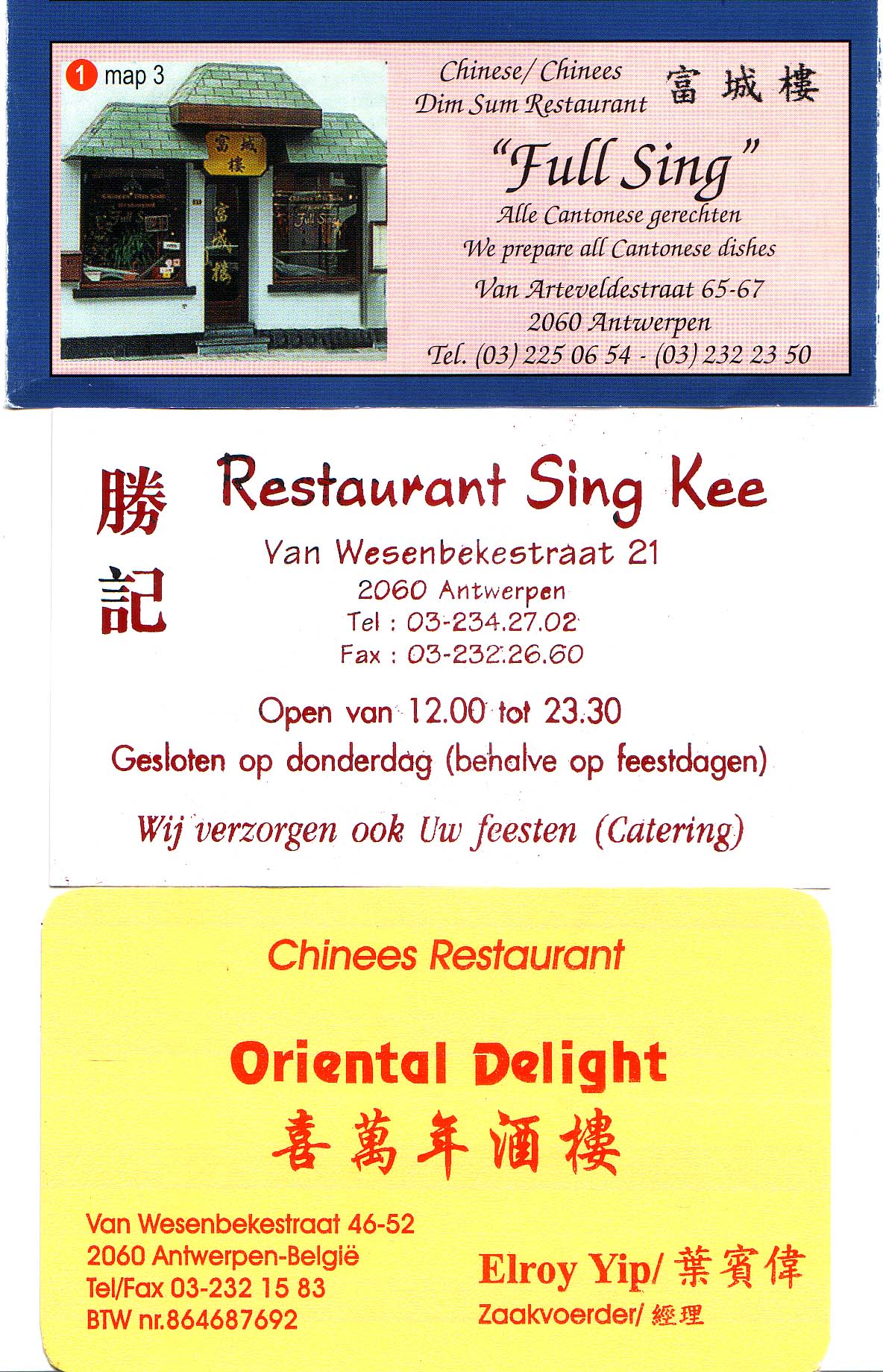 a city of half million, is in Belgium. Known for its diamonds, artists, and its financial center, more than sixteen million people live in this, the most densely populated country in the western world. Among them are fifty thousand whose heritage is Indonesian. Twice that many are Japanese, a quarter million are Turks or Moroccan guest workers, and only about ten thousand are Chinese. Seven thousand of these live in the capital city of Brussels. Antwerp, Europe's second largest port, is on the Schelt River. It has the second largest number of Chinese restaurants in Belgium with one just off the Grote Markt or main square. It is called Shang Hai and while its namesake is friendly, this eatery is not. They did show us their menu, even gave a business card, but but we were looking at them and when they learned our purpose, grabbed back both and forbade our staying or saying anything about the place. That is why no address is given. We wonder if they were spooked because many Chinese restaurants in Antwerp are closed, that is permanently out of business.
a city of half million, is in Belgium. Known for its diamonds, artists, and its financial center, more than sixteen million people live in this, the most densely populated country in the western world. Among them are fifty thousand whose heritage is Indonesian. Twice that many are Japanese, a quarter million are Turks or Moroccan guest workers, and only about ten thousand are Chinese. Seven thousand of these live in the capital city of Brussels. Antwerp, Europe's second largest port, is on the Schelt River. It has the second largest number of Chinese restaurants in Belgium with one just off the Grote Markt or main square. It is called Shang Hai and while its namesake is friendly, this eatery is not. They did show us their menu, even gave a business card, but but we were looking at them and when they learned our purpose, grabbed back both and forbade our staying or saying anything about the place. That is why no address is given. We wonder if they were spooked because many Chinese restaurants in Antwerp are closed, that is permanently out of business.
This city is the only one we visited with a Chinatown. It is two parallel blocks near the main train station, with a pair of fu dogs at each end. They were dedicated in 2001. Virtually every Chinese restaurant is on these two streets, about fifteen in all. Except for our first experience, owners and workers were very friendly; and their food, mostly Cantonese, looked good. FULL SING at Van Arteveldstraat 65-67 is a typical Chinese restaurant, but atypical because it advertises in the Welcome to Antwerp brochure. It seats more than seventy, and is in business sixteen years. The menu lists dishes in Belgian, French, and English, and it offers forty-nine different dim sum selections. They are on a separate, check-it-off two-sided order sheet, and the couple we tasted were good. Unlike most other Chinese restaurants in Antwerp, Full Sing does not close between lunch and dinner.
Sea foods here include oysters, sole, carp, eel, turbot, salmon, Tilapia, lobster, shrimp and others, all made several ways, including 'your way.' There are fifteen soup selections, a like number of hot pot/casseroles, and two dozen pasta or over-rice choices. Roast ducks hang in this and many restaurant windows. All look darker and roasted longer than in the United States. We are told by the Belgian-born Chinese owner, a combination of health rulings and local preferences, may be why. He says about two hundred Chinese live in Antwerp, and Belgian-born Chinese restaurant ownership is common. He advises that very few tourists patronize his restaurant, and at three one afternoon we see many Chinese enjoying good-looking Chinese food.
Most restaurants in this city have no take-away menu. But unlike Shang Hai, he gives us a regular and a dim sum menu and two business cards. This is Pentecostal Sunday, he says, do not expect all Chinese restaurants to be open.
One that is, SING KEE at Van Wesenbekestraat 21, is small with tables on two floors and twenty-two dim sum selections. Unusual on this menu is the comment that order four to ten of the same item and discounts are available. Sing Kee staff tell us they do a lot of catering for special occasions, and they offer many ways to prepare various meat and fish items. The largest Chinese restaurant we see, is called ORIENTAL DELIGHT at Van Wesenbekestraat 46-52. Here, they feature nearly a hundred dim sum selections, all to be ordered checking off their two-sided sheet which is only in Chinese. Perhaps the only ones who do, can read Chinese. Elroy Yip owns this Chinese eatery that seats more than a hundred. He is Cantonese, nd the restaurant is empty when we get there. Holiday today, he advises.
BADEN-BADEN 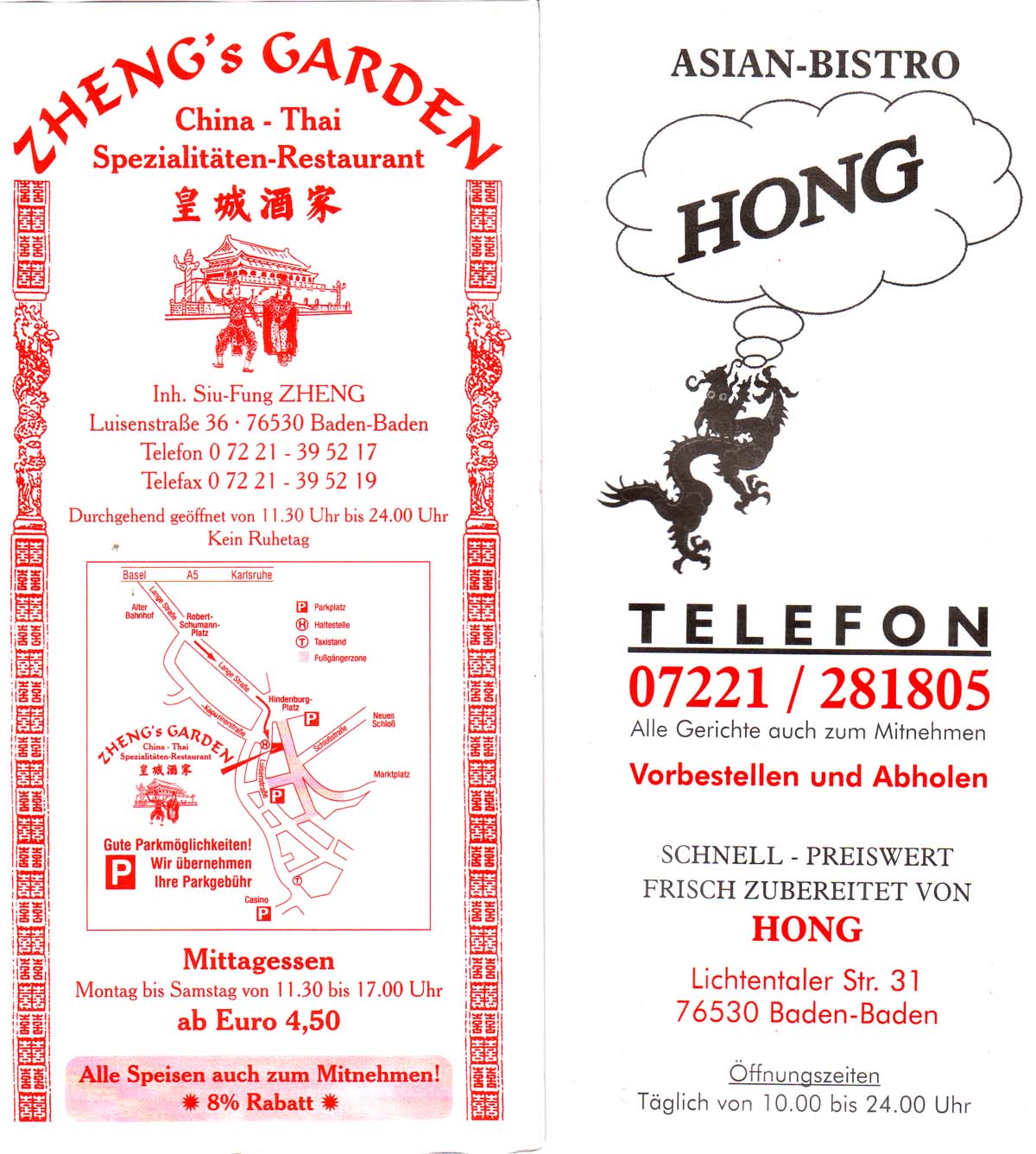 in the southwest of Germany has a population of fifty-five thousand. In this tourist mecca, known for its casinos and thermal springs, we find four Chinese restaurants serving a quarter of a million hotel tourists each year. One of them, ZHENG'S GARDEN at Luisenstrasse 36 is on a quiet street near the main spa and casino. It is on a second floor, and is a very upscale restaurant. One can eat outside and enjoy Chinese and a few Thai foods. The menu is extensive; the one for take-away includes twelve sides with two hundred dishes and eight additional family menus. For those dining alone, there are three different 'three-in-one' plates, one with roast duck and morels, deep-fried pork, and salad. It looks quite inviting. So does ASIAN BISTRO HONG at Lichtentaler Strasse 31 has a large menu of more than a hundred items. It is found on a quiet corner, is in a very upscale area, and has very inexpensive offerings. It is small and features many Chinese foods, fourteen from Thailand, and six from Vietnam. They are proud that they are made with fresh ingredients and with German flavor. The menu is a two-sided plastic-covered place mat. For take-away, one selects items on a paper one.
in the southwest of Germany has a population of fifty-five thousand. In this tourist mecca, known for its casinos and thermal springs, we find four Chinese restaurants serving a quarter of a million hotel tourists each year. One of them, ZHENG'S GARDEN at Luisenstrasse 36 is on a quiet street near the main spa and casino. It is on a second floor, and is a very upscale restaurant. One can eat outside and enjoy Chinese and a few Thai foods. The menu is extensive; the one for take-away includes twelve sides with two hundred dishes and eight additional family menus. For those dining alone, there are three different 'three-in-one' plates, one with roast duck and morels, deep-fried pork, and salad. It looks quite inviting. So does ASIAN BISTRO HONG at Lichtentaler Strasse 31 has a large menu of more than a hundred items. It is found on a quiet corner, is in a very upscale area, and has very inexpensive offerings. It is small and features many Chinese foods, fourteen from Thailand, and six from Vietnam. They are proud that they are made with fresh ingredients and with German flavor. The menu is a two-sided plastic-covered place mat. For take-away, one selects items on a paper one.
BASEL 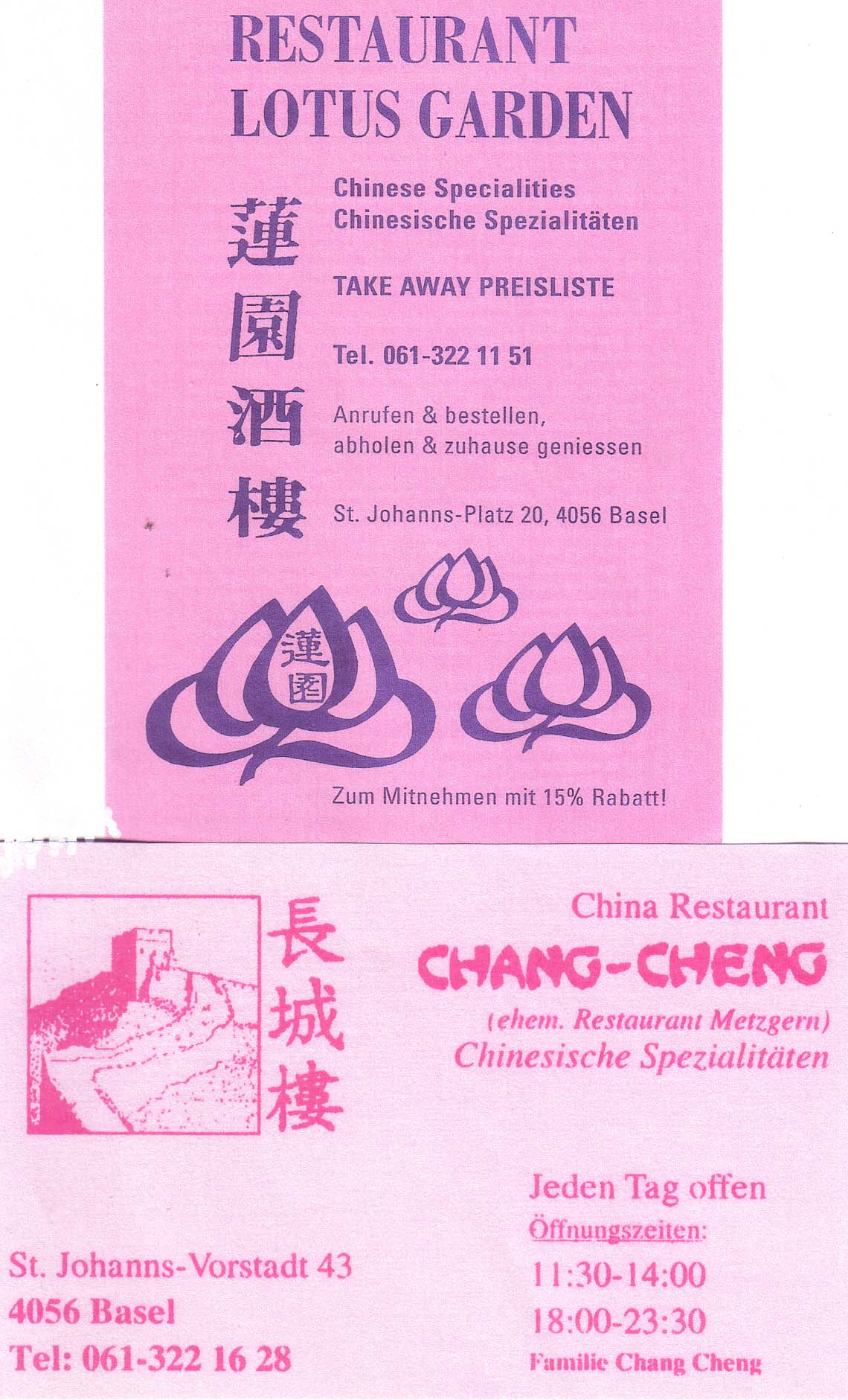 is Switzerland's second largest city, one with a population of about two hundred thousand. It has seven or eight sit-down Chinese restaurants, most with liquor licenses, and an equal or larger number of take-away places. We call attention to two, both attracting customers from all over the city. The first is RESTAURANT LOTUS GARDEN at St Johannsplatz 20, is only one block from where our cruise ship docks. The Lee family have owned this popular sixty-seat place for nineteen years. While we visit, groups and individuals order their favorite dishes, some not even on the menu. The food looks and smells great, the portions are larger than most, and the vibes in this place are all positive. Mr. Lee Seeheng is Malaysian-Chinese and very restaurant savvy. He does a good business and touts his take-away as fifteen percent less than when eating in. He is also the only one with chopsticks and flatware at every place making all who eat here feel comfortable. This Chinese restaurant looks small and Swiss from the outside. Inside are many Chinese items, and Peking Duck to drool for.
is Switzerland's second largest city, one with a population of about two hundred thousand. It has seven or eight sit-down Chinese restaurants, most with liquor licenses, and an equal or larger number of take-away places. We call attention to two, both attracting customers from all over the city. The first is RESTAURANT LOTUS GARDEN at St Johannsplatz 20, is only one block from where our cruise ship docks. The Lee family have owned this popular sixty-seat place for nineteen years. While we visit, groups and individuals order their favorite dishes, some not even on the menu. The food looks and smells great, the portions are larger than most, and the vibes in this place are all positive. Mr. Lee Seeheng is Malaysian-Chinese and very restaurant savvy. He does a good business and touts his take-away as fifteen percent less than when eating in. He is also the only one with chopsticks and flatware at every place making all who eat here feel comfortable. This Chinese restaurant looks small and Swiss from the outside. Inside are many Chinese items, and Peking Duck to drool for.
Closer to the market and main shopping is CHANG-CHENG on St Johanns-Vorstadt 43 is part-owned by a Vietnamese woman who used to work for her partner, an unrelated Swiss gentleman. This one hundred sixty-seat very up-scale restaurant opened in April 2005, and serves classic Chinese food with no nod to local taste. Their duck, a good example of this, is cooked at a lower temperature, and is juicier than any other we saw while on this cruise. Wonder if the aforementioned Mr. Lee gets his from here.
The owners told us the appreciation for authentic Chinese food is growing. Their menu is extensive, has items not typically Cantonese; and that it is getting more popular daily, we were told. The one-hundred-plus-item menu, like the restaurant, is large. It is in German and English, and one of the few encountered with Sichuan dishes. The service is classically Swiss. Like most restaurants in this country, the restaurant closes between lunch and dinner. The owner told us their customers are knowledgeable and want more good Chinese food than ever before, and that is why they opened this upscale Chinese eatery.
BERNKASTEL,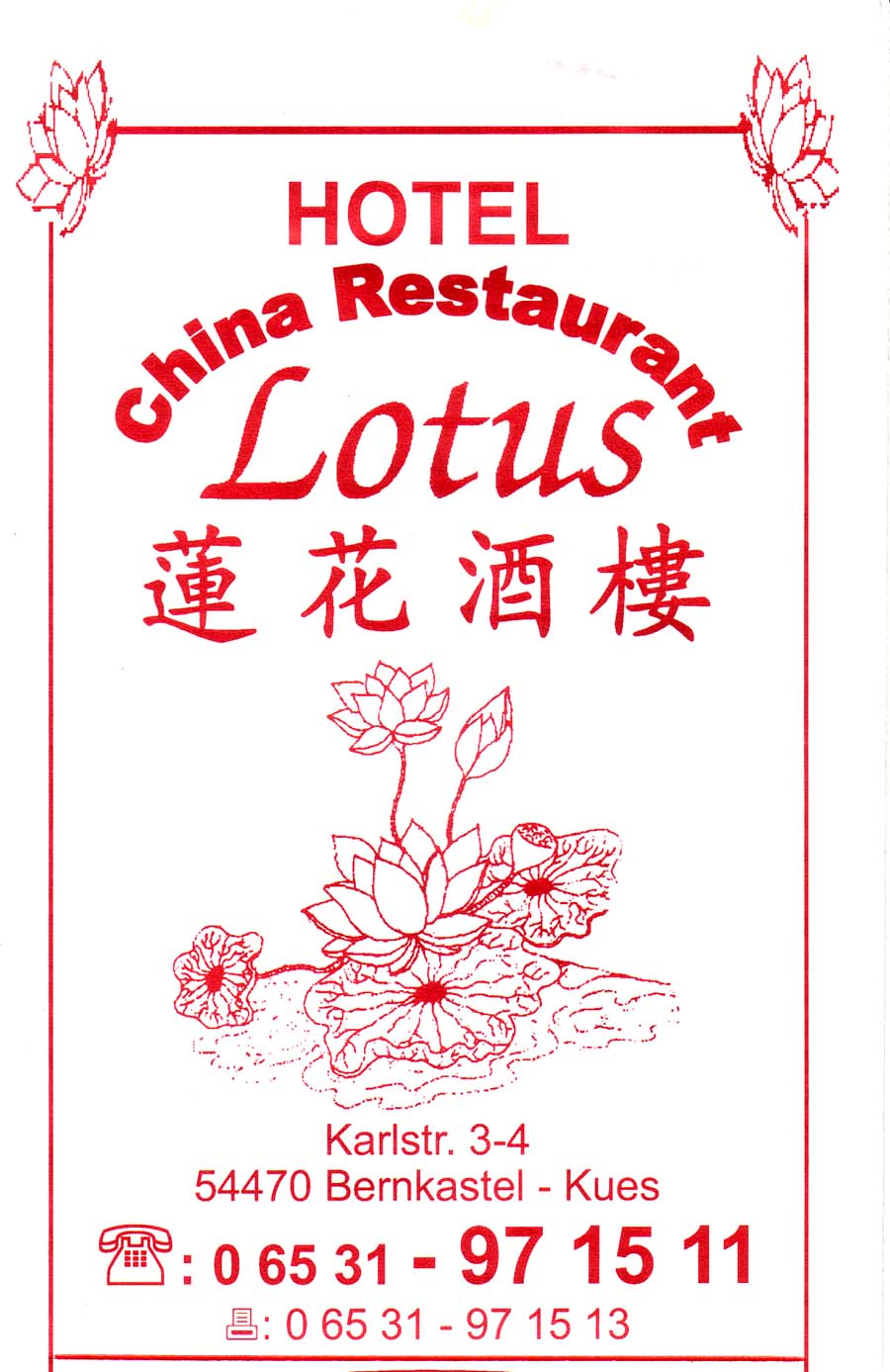 in Germany, is on the Mosel River. Views from the castle look gorgeous, as do many of the Chinese dishes at its only Chinese restaurant. This HOTEL CHINA RESTAURANT LOTUS at Karlstrasse 3-4 is, as one would expect, in the Lotus Hotel. Their Lotus Plate and the Eight Kinds of Meat with Vegetables are stunning at one lunch table. This and other house specialities sit on half the occupied tables. So do Ti-Pan or sizzling dishes, all with black bean sauce. Sweet and sour is another option, but the owner says it is not popular here. Two days notice is required for Peking Duck. Most other items are Cantonese, a large number sweet and sour dishes. Besides the more than hundred items, are many set menus serving from one to five persons. A few are 'Szechuan-Art' dishes or Indonesian selections such as a satay or gado-gado.
in Germany, is on the Mosel River. Views from the castle look gorgeous, as do many of the Chinese dishes at its only Chinese restaurant. This HOTEL CHINA RESTAURANT LOTUS at Karlstrasse 3-4 is, as one would expect, in the Lotus Hotel. Their Lotus Plate and the Eight Kinds of Meat with Vegetables are stunning at one lunch table. This and other house specialities sit on half the occupied tables. So do Ti-Pan or sizzling dishes, all with black bean sauce. Sweet and sour is another option, but the owner says it is not popular here. Two days notice is required for Peking Duck. Most other items are Cantonese, a large number sweet and sour dishes. Besides the more than hundred items, are many set menus serving from one to five persons. A few are 'Szechuan-Art' dishes or Indonesian selections such as a satay or gado-gado.
All dishes come with rice. Many patrons have theirs with fried potatoes or baked noodles. Only one or two have selected a fish dish, a few more have one of the seven different prawn dishes. This is meat and potatoes country, and this Chinese restaurant embodies that in the one fewer than two hundred dishes they serve. Fifteen are desserts, ten dessert variations with ice cream.
BOPPARD,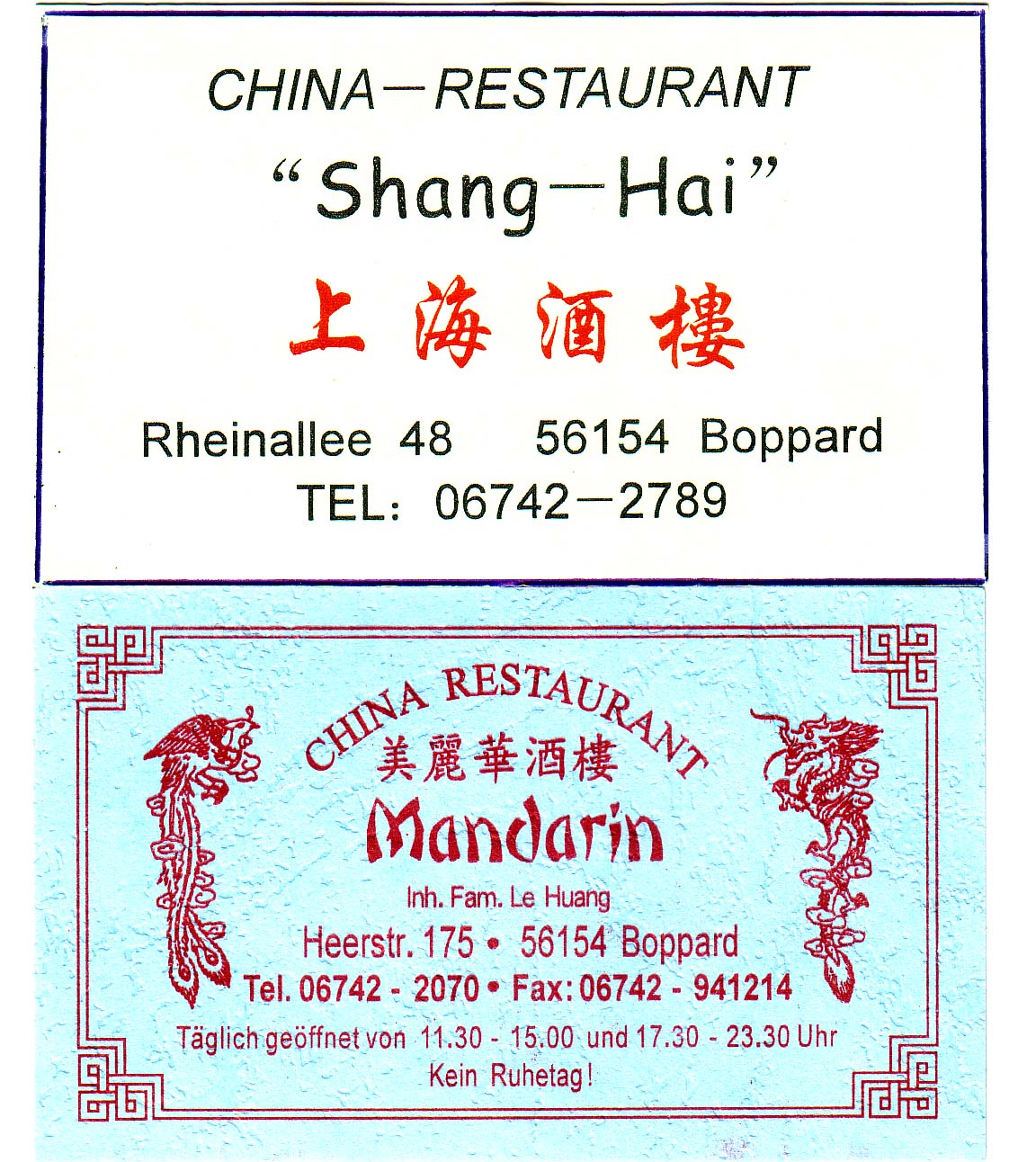 in Germany, is a small seventeen thousand person town at the bend of the Rhine River. It boasts two Chinese restaurants and another one serving Vietnamese, Thai, and Chinese food. CHINA RESTAURANT MANDARIN at Heerstrasse 175 and CHINA RESTAURANT SHANG HAI at Rheinallee 48 is the former, ASIA RESTAURANT Liniuss Strasse 7 the latter. They offer a ten percent discount for take-away, close between lunch and dinner, serve a buffet lunch, and have more than a hundred choices at dinner-time. There are similarities in their menus, prices, and the look of their foods. Mr. Huang Ge Wei, who owns the Mandarin tells us his is the oldest--twenty-five years old, and that he and his family own it but five of those years. He is from Wuzhou near Shanghai, and locals tell us when he makes dishes from his region of China, they differ and are better than all other Asian food in this town. Except for that, all Chinese food in this town does have strong German influences.
in Germany, is a small seventeen thousand person town at the bend of the Rhine River. It boasts two Chinese restaurants and another one serving Vietnamese, Thai, and Chinese food. CHINA RESTAURANT MANDARIN at Heerstrasse 175 and CHINA RESTAURANT SHANG HAI at Rheinallee 48 is the former, ASIA RESTAURANT Liniuss Strasse 7 the latter. They offer a ten percent discount for take-away, close between lunch and dinner, serve a buffet lunch, and have more than a hundred choices at dinner-time. There are similarities in their menus, prices, and the look of their foods. Mr. Huang Ge Wei, who owns the Mandarin tells us his is the oldest--twenty-five years old, and that he and his family own it but five of those years. He is from Wuzhou near Shanghai, and locals tell us when he makes dishes from his region of China, they differ and are better than all other Asian food in this town. Except for that, all Chinese food in this town does have strong German influences.
STRASBOURG,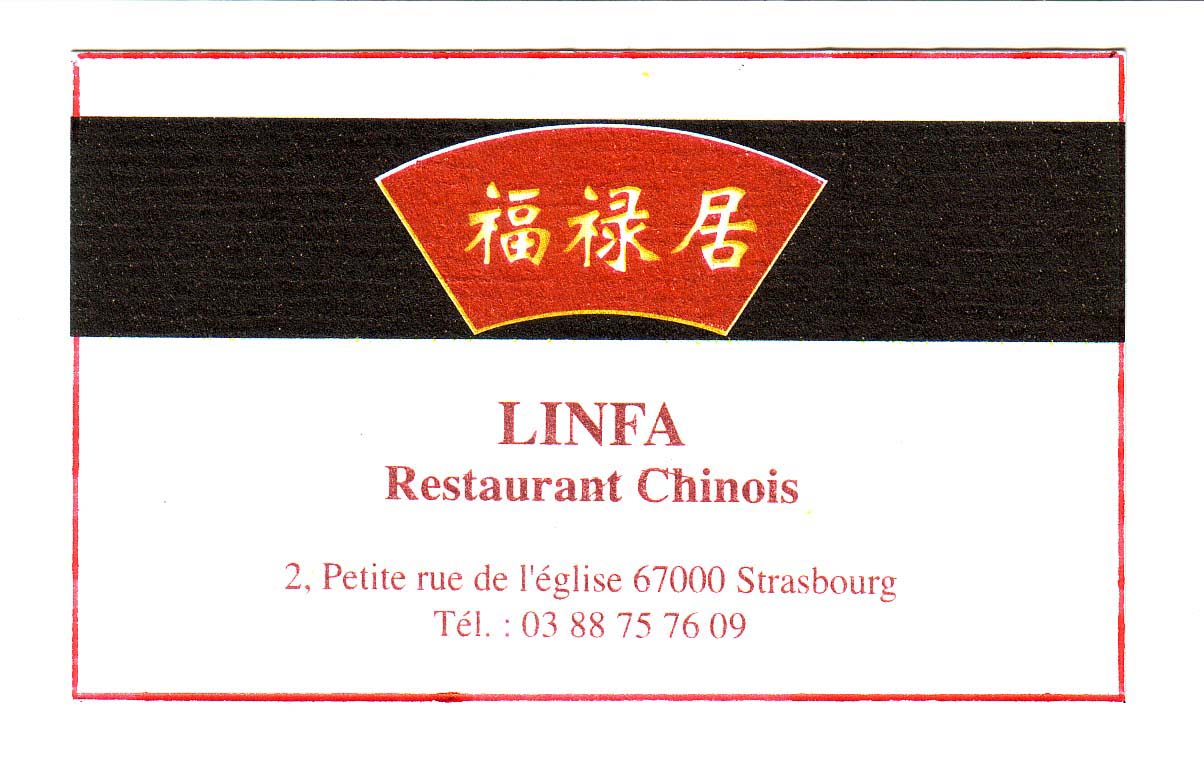 a river port in Northern France, has many Chinese restaurants. As we were here for but a short few hours, we opted to eat at the largest and most touted Chinese restaurant. It is near St Peters Church, called LINFA at #2 Petote Rue de l’Eglise. The food here is simple, the place looks sophisticated, and the the clientele matches. Most men wear jackets and ties, most ladies are very well-dressed. Some of the dishes match the customers, but with simple decor, none, or what attempts to look elegant. Place settings are upscale and economically mismatched with fork, chopsticks, chopstick rests, plate, and an inexpensive paper napkin. At lunch, tables are paper-covered and folks are noisy.
a river port in Northern France, has many Chinese restaurants. As we were here for but a short few hours, we opted to eat at the largest and most touted Chinese restaurant. It is near St Peters Church, called LINFA at #2 Petote Rue de l’Eglise. The food here is simple, the place looks sophisticated, and the the clientele matches. Most men wear jackets and ties, most ladies are very well-dressed. Some of the dishes match the customers, but with simple decor, none, or what attempts to look elegant. Place settings are upscale and economically mismatched with fork, chopsticks, chopstick rests, plate, and an inexpensive paper napkin. At lunch, tables are paper-covered and folks are noisy.
The Assorted Roasted Meats entice, it says with six different items. So do Assorted Steamboat Appetizers. Both were neither winners nor losers, just simple looking and low on any taste scale. Likewise the stir-fry dishes. We skip out before dessert, while others indulge from the extensive menu. My husband did not mind that, but has yet to forgive for insisting we eat here instead of one of the local non-Chinese restaurants this city is famous for.
TRIER,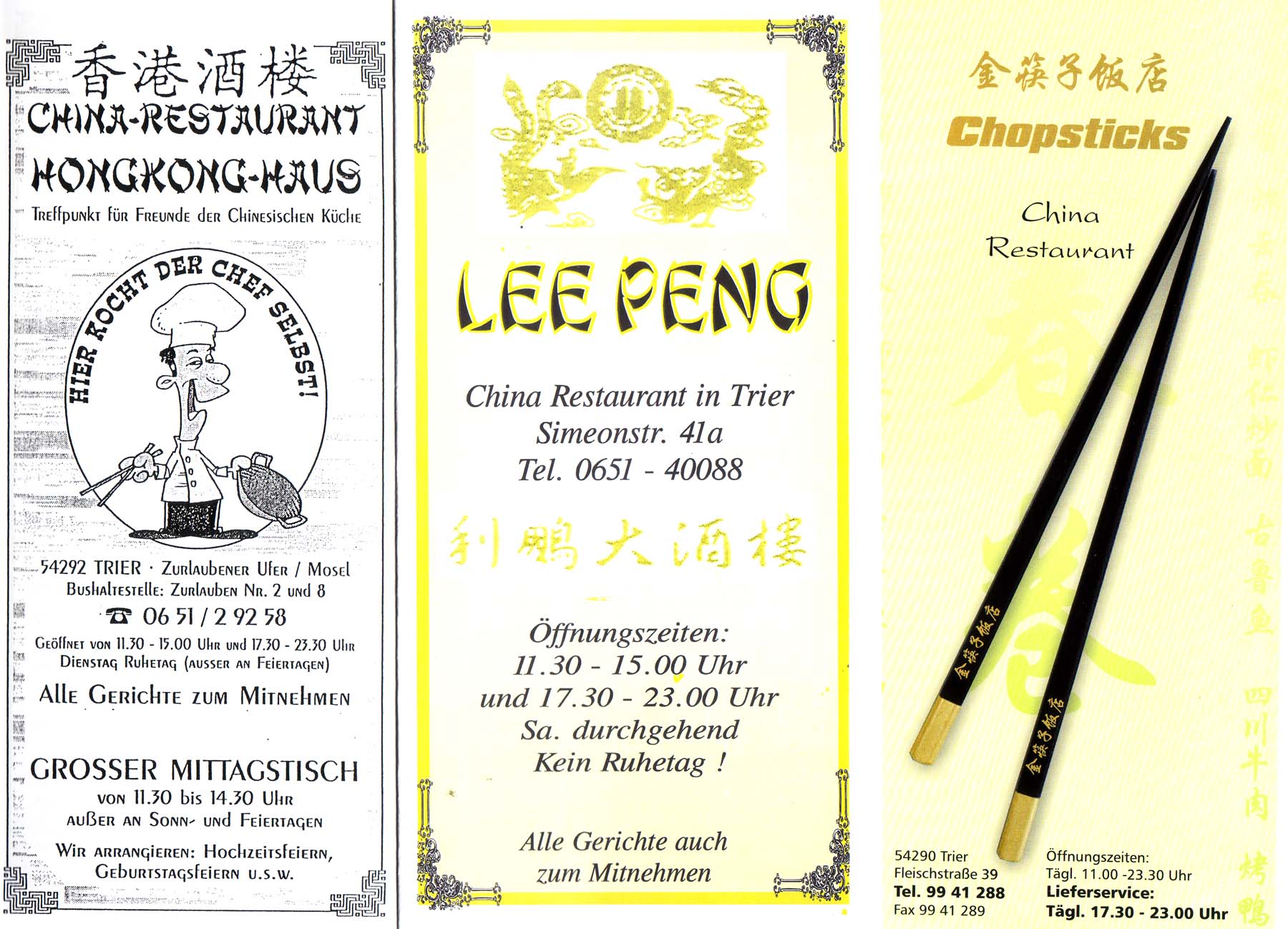 on the Mosel River, is a small German city of a hundred thousand with between one and two thousand Chinese in residence. Most are university students; one of whom told us there are twenty or so Chinese restaurants in town. That disagrees with two Chinese restauranteurs who say there are but ten. The tourist office calls both incorrect and advises just five Chinese restaurants, the largest the Mandarin. With luck on our side, this 'buffet only at lunch' eatery was closed; the dinner menu on the window looks sophisticated and varied.
on the Mosel River, is a small German city of a hundred thousand with between one and two thousand Chinese in residence. Most are university students; one of whom told us there are twenty or so Chinese restaurants in town. That disagrees with two Chinese restauranteurs who say there are but ten. The tourist office calls both incorrect and advises just five Chinese restaurants, the largest the Mandarin. With luck on our side, this 'buffet only at lunch' eatery was closed; the dinner menu on the window looks sophisticated and varied.
Next largest is LEE PENG at Simeonsstrasse 41 A is not the oldest. This place has been there for thirteen years and is attuned to today's hype. The menu has little numbers after most dishes. They match a list of additives near its end. Everyone we spoke to, there and elsewhere, tell us it is the only Chinese menu providing that information. Here the food cares about the customer, and its presentations are important,. Next we locate a fancy place called CHOPSTICKS at Fleishstrasse 39. With Germanic taste, its menu includes only two fish dishes. Main courses come with high-class presentations; and the four Malaysian dishes on the menu are at many a table. Desserts are simple, as is the Pineapple with Honey. So is a Baked Broccoli. A service staff member advises it is rarely ordered in response to our query about how is it made.
TRABEN-TRABACH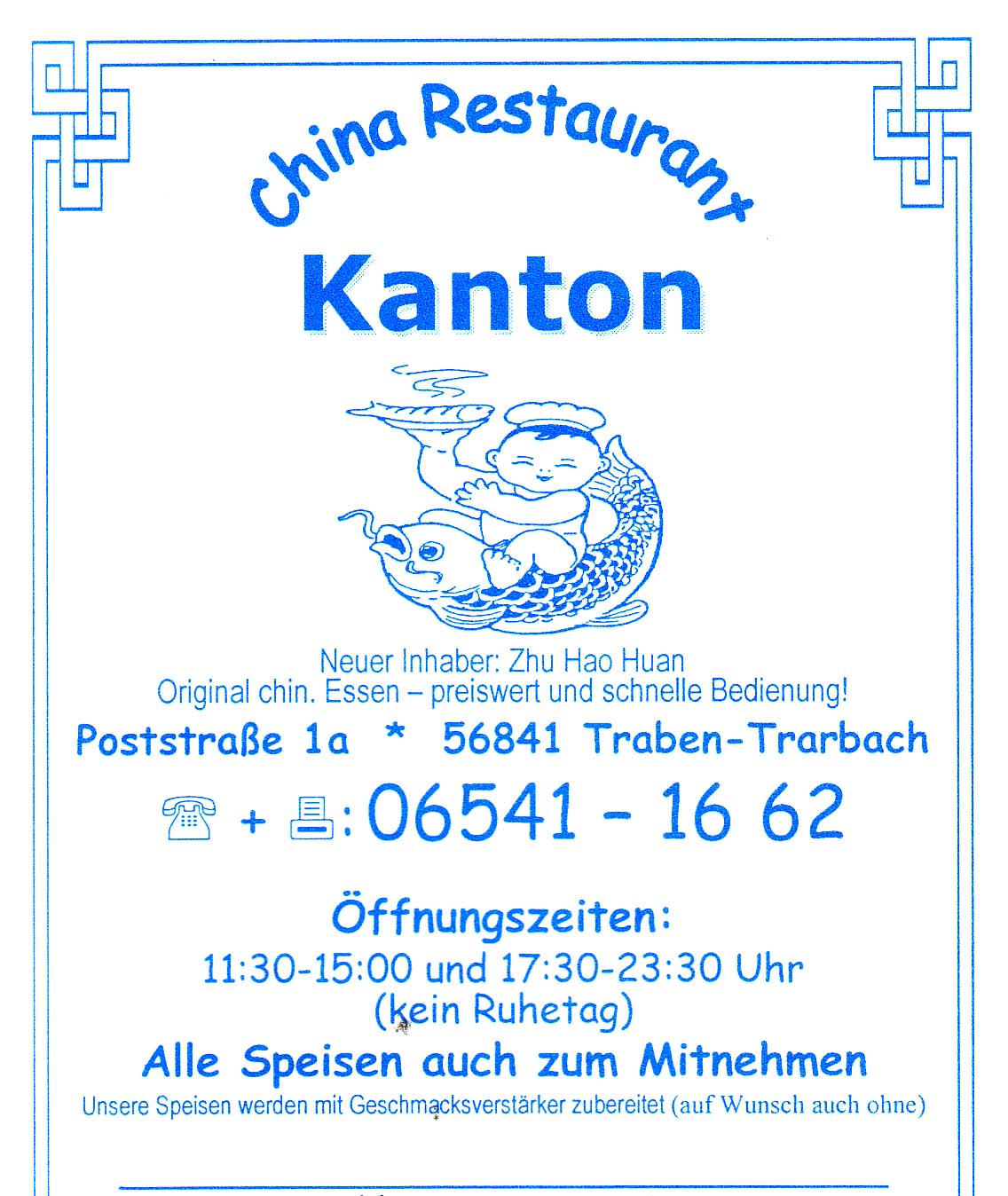 is really two German towns, the Mosel River dividing their combined population of six thousand. Also a division, is the Chinese restaurant called KANTON at Postrasse 1A. It is on the bridge between them. Like most European restaurants, there are lunch specials. A goodie we see is Duck with Vegetables, probably better that Crab with Chop Suey. Peking Duck needs ordering a day in advance, and it sets you back about a hundred American ducks, I mean bucks. Better looking and quite exciting are Goose-nest, Stork-nest, Eagle-nest, and Papagei-nest. The last one is surimi, did not bother to inquire about the others.
is really two German towns, the Mosel River dividing their combined population of six thousand. Also a division, is the Chinese restaurant called KANTON at Postrasse 1A. It is on the bridge between them. Like most European restaurants, there are lunch specials. A goodie we see is Duck with Vegetables, probably better that Crab with Chop Suey. Peking Duck needs ordering a day in advance, and it sets you back about a hundred American ducks, I mean bucks. Better looking and quite exciting are Goose-nest, Stork-nest, Eagle-nest, and Papagei-nest. The last one is surimi, did not bother to inquire about the others.
WORMS, 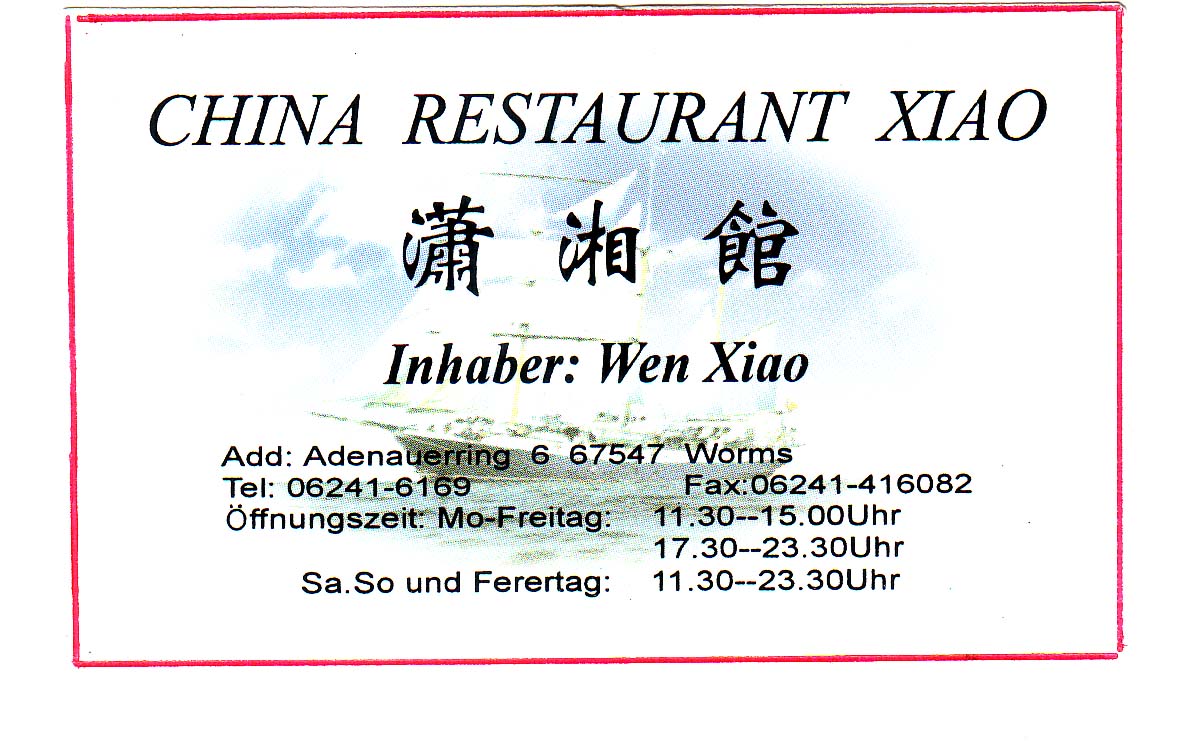 also in Germany, has Chinese eatery possibilities. After all, it does have a small Asian market and several potential Chinese fast food spots, albeit with strong Germanic influences. Better than these, there is a lovely place called CHINA RESTAURANAT XIAO at Adenauerring 6. At lunch, most opt for the buffet, but quite a few locals order from the regular menu. Avoiding the all too many Chao Mian or Chop Suey selections, duck dishes entice. Grilled Duck with Mixed Vegetables and Almonds is a popular choice; and we see why. There are several fish dishes on this menu, the one with curry sauce fills the air and looks like it tastes filling, too. This restaurant's menu includes three fixed-price fixed-menus for two. Every one is selected by the couples we see; they must be regulars, as they chat, table to table, and smile when eating. Their food looks luscious.
also in Germany, has Chinese eatery possibilities. After all, it does have a small Asian market and several potential Chinese fast food spots, albeit with strong Germanic influences. Better than these, there is a lovely place called CHINA RESTAURANAT XIAO at Adenauerring 6. At lunch, most opt for the buffet, but quite a few locals order from the regular menu. Avoiding the all too many Chao Mian or Chop Suey selections, duck dishes entice. Grilled Duck with Mixed Vegetables and Almonds is a popular choice; and we see why. There are several fish dishes on this menu, the one with curry sauce fills the air and looks like it tastes filling, too. This restaurant's menu includes three fixed-price fixed-menus for two. Every one is selected by the couples we see; they must be regulars, as they chat, table to table, and smile when eating. Their food looks luscious.
OVERALL, good and interesting Chinese food is coming, some already in small European cities and towns. Remember to visit the small-city Chinese restaurants at meal hours because most do not proffer food between them. And do not look for a place for a very late dinner. Most are small and tend to close after what they perceive is is their last customer. That means that lots will close earlier than expected. With one or two exceptions, Chinese food looks and smells good, but tastes closer to the country of location than that of its country of origin. Most food looks Cantonese, little fish is served, and even little seafood. Desserts can be plentiful. Overall, menu selections and presentations are better than those we have seen or tasted on earlier trips; and there is no need to skip an urge for Chinese food; absolutely none!

Copyright © 1994-2025 by ISACC, all rights reserved
Address
3 Jefferson Ferry Drive
S. Setauket NY 11720